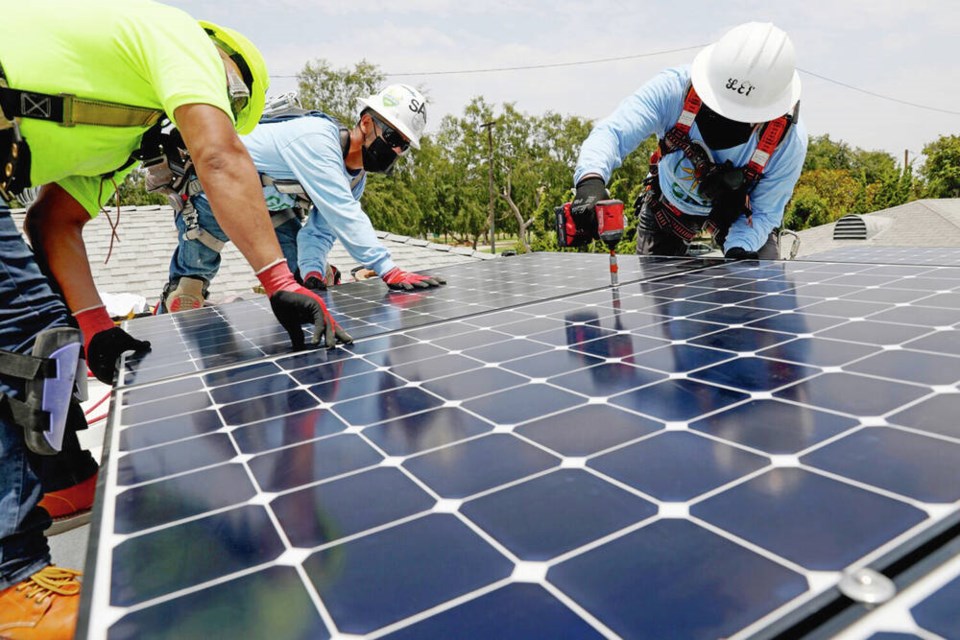Courtesy of the Times Colonist
Photo: A crew installs solar panels in Los Angeles. Trevor Hancock writes that wind and solar could supply half of all electricity in the early 2030s, especially as costs decline about 20 to 25 per cent for each doubling of installed capacity. Gary Coronado, Los Angeles Times, TNS
The fifth great turnaround proposed by the Earth For All (E4A) initiative of the Club of Rome is a complete restructuring of our energy system.
But it’s more than that, since energy is so bound up in all we do. Energy has powered our civilization ever since we first learned to use fire to warm us, cook and scare off predators.
As we moved through the ages of wood, coal, oil, gas and nuclear, we accumulated more and more “energy servants.”
Today, by one estimate, every American has at their command the equivalent of roughly 150 “servants” working 24/7 every day of the year, and that does not seem to include the energy used outside America to make all the stuff that is acquired.
So transforming our energy system also means transforming our way of life, our societies and our economies. In their chapter on the Energy Turnaround, E4A’s authors discuss, among other things, “a shift to more conscious production, and to consuming less,” as well as the need for a circular economy and manufacturing practices to both recycle materials and use less materials in products.
At the heart of their proposed strategy lies greater energy and resource efficiency. As is the case with food, as I noted last week, we waste a lot of energy.
Earth For All cites a 2018 study in Nature Energy by Arnulf Grubler and colleagues that found global energy demand by 2050 could be 40 per cent lower than now if all known energy efficiencies were implemented, in spite of population increases and rising affluence.
Greater efficiencies stem from improving our buildings and changing our transportation systems, E4A stresses.
Improved insulation is “a better solution than adding air conditioning or heaters,” daylighting buildings is better than using lights, and refurbishing is better than demolishing buildings.
We also need to redesign our cities for walkability and livability, aiming for denser development, public transportation and “smaller vehicles, and fewer vehicles on the roads.”
Those vehicles should be electric, as should pretty much everything else. Indeed “electrify [almost] everything” is their second proposed solution: “we should substitute carbon molecules with electrons wherever something needs energy.”
They address a number of myths put forward, mainly by the fossil fuel industry and their allies: No, energy transitions are not slow, and we are midway through this transition, at the point where renewable energy is as cheap as fossil fuels, or cheaper, in many places.
No, many sectors are not hard to electrify — the technologies to do so exist. No, it is not difficult to change people’s behaviour, and no, clean energy is not intermittent and unreliable, if proper planning is done.
In fact, “the solutions are market-ready,” although we do need to ensure that the new minerals mining that is needed does not exploit poor nations or vulnerable people, and does not create land degradation and pollution.
Part of that mitigation, of course, is that greater efficiency reduces demand and its accompanying harms.
Earth For All’s third proposed solution is an exponential growth in new renewables. Wind and solar, they point out, doubled from five per cent of all global electricity production in 2016 to 10 per cent in 2021.
At that rate, they note, these technologies could supply half of all electricity in the early 2030s, especially as costs decline about 20 to 25 per cent for each doubling of installed capacity.
Another energy source to consider is ultradeep geothermal energy, which has caught the attention of Thomas Homer-Dixon and his colleagues at the Cascade Institute at Royal Roads University.
This involves creating heat-exchange reservoirs in hot, dry rock more than five kilometres below Earth’s surface. These geothermal power plants, they write, “could be built nearly anywhere on Earth and provide an essentially limitless supply of net-zero power.”
By pioneering this approach, they suggest, Canada could become a deep geothermal superpower.
Not only will these changes help us avoid the worst of climate change, they will also result in cleaner air and better health, especially in low and middle-income countries, who will need both technological and financial support to make these changes.
But as the countries with the highest carbon footprints, high-income countries such as Canada need to lead the way toward energy for all.
thancock@uvic.ca
Dr. Trevor Hancock is a retired professor and senior scholar at the University of Victoria’s School of Public Health and Social Policy
